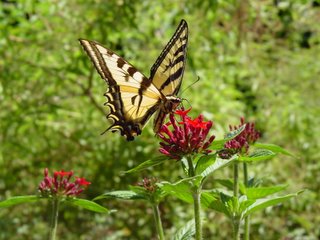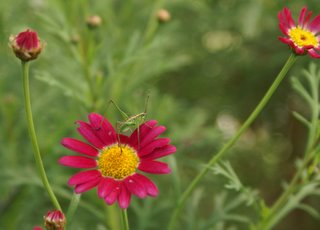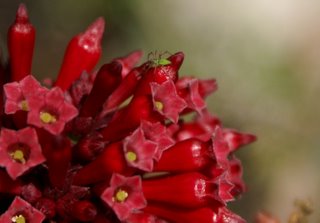Red used to be mostly invisible to me in the sense that I completely ignored its existence in clothing, home furnishings, cars, and flowers. I'm one of those people who associate red with war, aggression, blood and The Man instead of love and passion. I'm more of a purple person, with happy dashes of yellow and orange framed with all varieties of comforting greens. But lately red has snuck its hot blooded way into my garden. One of the first invaders was an orphaned red pentas I reluctantly adopted. I stuck it in the worst section nearly barerooted two summers ago; it rewarded my concern with vermillion flower clusters in nearly all seasons, attracting swallowtail butterflies in summer.

This calendula, a new variety named Touch
 of Red, blooms dark orange but I would call this bud cinnamon, or maybe brick. This is the adult of the nymph previously posted here.
of Red, blooms dark orange but I would call this bud cinnamon, or maybe brick. This is the adult of the nymph previously posted here.I am a sucker for marguerite daisies, which the nursery trade insists on calling Argyranthemums to make them seem more exotic I guess. Anyway, they keep breeding new varieties and this one, Ruby Slippers, has tu
 rned out to be a very good performer. But, is it really red? In this photo, with the katydid nymph, it looks pink. An informal survey of my family members in the field with a real live plant concluded these ruby slippers are a velvety purple with undertones of pomegranate red.
rned out to be a very good performer. But, is it really red? In this photo, with the katydid nymph, it looks pink. An informal survey of my family members in the field with a real live plant concluded these ruby slippers are a velvety purple with undertones of pomegranate red.  I planted cestrum to attract hummingbirds. The flowers of cestrum newellii are described by Sunset Western Garden Book as "bright crimson". The dictionary defines crimson as deep red inclining toward purple. Maybe my pigments are defective, but I don't see the purple here; I think it's more like scarlet, referring back to Webster: "a brilliant red tinged with orange". The green lynx spiderling has no opinion since it's all invisible to him.
I planted cestrum to attract hummingbirds. The flowers of cestrum newellii are described by Sunset Western Garden Book as "bright crimson". The dictionary defines crimson as deep red inclining toward purple. Maybe my pigments are defective, but I don't see the purple here; I think it's more like scarlet, referring back to Webster: "a brilliant red tinged with orange". The green lynx spiderling has no opinion since it's all invisible to him.This ranunculous bud is speckled with drops from the rain we had yesterday. I'd say this is really a tomato red. I like tomatoes a bit more than red ranunculous; these were being stocked temporarily in the yard before shipping to someone else's redder landscape. Anyway, the bug on this bud is me reflected in the center droplet.

If the red in these flowers is invisible to the bugs I found on them, what do they see instead? If I can learn to see shades of red in the garden, can I hope to learn to see ultraviolet? When Roget's has over 16 synonyms for red, all of which are subjective, can we really presume to label anything merely red which might be tending toward purple, or even orange?
No comments:
Post a Comment